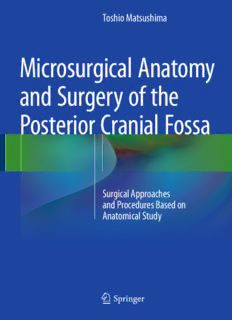
Microsurgical Anatomy and Surgery of the Posterior Cranial Fossa: Surgical Approaches and Procedures Based on Anatomical Study PDF
Preview Microsurgical Anatomy and Surgery of the Posterior Cranial Fossa: Surgical Approaches and Procedures Based on Anatomical Study
Toshio Matsushima Microsurgical Anatomy and Surgery of the Posterior Cranial Fossa Surgical Approaches and Procedures Based on Anatomical Study 123 Microsurgical Anatomy and Surgery of the Posterior Cranial Fossa Toshio Matsushima Microsurgical Anatomy and Surgery of the Posterior Cranial Fossa Surgical Approaches and Procedures Based on Anatomical Study ToshioMatsushima DepartmentofNeurosurgery FacultyofMedicine,SagaUniversity Saga,Japan ThisEnglishtranslationisbasedontheJapaneseOriginal“KouzugaikanoBishougekakaiboto Shujyutsu”byToshioMatsushima#SciMedPublications,2006 OriginallypublishedinJapanin2006 ISBN978-4-431-54182-0 ISBN978-4-431-54183-7(eBook) DOI10.1007/978-4-431-54183-7 SpringerTokyoHeidelbergNewYorkDordrechtLondon LibraryofCongressControlNumber:2014947536 #SpringerJapan2015 Thisworkissubjecttocopyright.AllrightsarereservedbythePublisher,whetherthewholeorpartofthematerialis concerned,specificallytherightsoftranslation,reprinting,reuseofillustrations,recitation,broadcasting,reproduction on microfilms or in any other physical way, and transmission or information storage and retrieval, electronic adaptation, computer software, or by similar or dissimilar methodology now known or hereafter developed. Exemptedfromthislegalreservationarebriefexcerptsinconnectionwithreviewsorscholarlyanalysisormaterial suppliedspecificallyforthepurposeofbeingenteredandexecutedonacomputersystem,forexclusiveusebythe purchaserofthework.Duplicationofthispublicationorpartsthereofispermittedonlyundertheprovisionsofthe CopyrightLawofthePublisher’slocation,initscurrentversion,andpermissionforusemustalwaysbeobtainedfrom Springer.PermissionsforusemaybeobtainedthroughRightsLinkattheCopyrightClearanceCenter.Violationsare liabletoprosecutionundertherespectiveCopyrightLaw. Theuseofgeneraldescriptivenames,registerednames,trademarks,servicemarks,etc.inthispublicationdoesnot imply,evenintheabsenceofaspecificstatement,thatsuchnamesareexemptfromtherelevantprotectivelawsand regulationsandthereforefreeforgeneraluse. Whiletheadviceandinformationinthisbookarebelievedtobetrueandaccurateatthedateofpublication,neitherthe authorsnortheeditorsnorthepublishercanacceptanylegalresponsibilityforanyerrorsoromissionsthatmaybe made.Thepublishermakesnowarranty,expressorimplied,withrespecttothematerialcontainedherein. Printedonacid-freepaper SpringerispartofSpringerScience+BusinessMedia(www.springer.com) Foreword Itisagreathonortohavebeenaskedtowritetheforewordtothistextthatbringsordertoone ofthemostcomplexareastheneurosurgeonfaces.Neurosurgeonsarefortunatetohaveaccess tothisbookbyoneoftheworld’sgreatmastersofposteriorfossasurgery.Thisvolumestands as a tribute to Dr. Matsushima’s dedication to academic excellence and operative neurosur- gery.ProfessorMatsushimahascompletedmorethan40yearsofintensivestudyofposterior fossa anatomy and has translated that information into accurate, gentle, and safe surgical approaches tothisdelicate area. Ihave learned much fromhis previous workand know that neurosurgeons around the world will benefit greatly from this volume. Dr. Matsushima presents a wealth of information in a concise, well organized format. This book provides a detailedreviewoftheanatomyoftheposteriorfossafollowedbydescriptionsoftheoperative approaches. I found the contents of this book to be interesting, enlightening, and beneficial evenafterdecadesofneurosurgicalpractice.CongratulationstoProfessorMatsushima,oneof the world’s greatest authorities on the posterior fossa, for this outstanding contribution. The study of this volume will make the neurosurgeon’s work more accurate, gentle, precise and safe. Gainesville,FL,USA AlbertL.Rhoton,Jr.,M.D. v Foreword Iwouldliketocongratulatethatthisbook,originallypublishedinJapanese,isnowavailable in English to benefit neurosurgeons worldwide. It is a compilation of many years’ work by Dr.ToshioMatsushima,focusingonthemicrosurgicalanatomyoftheposteriorfossa. Dr.Matsushimabegan hisneurosurgicalcareer atKyushuUniversity,Japan in1974,and wasoneofthepioneeringresearcherstostudyabroadatDr.AlbertL.Rhoton’slaboratoryat theUniversityofFloridain1980.Hispassionformicrosurgicalanatomywasinspiredbyhis mentorDr.Rhoton’sworkduringhistimeatGainsville,andhehascontinuedtopursuethis subjecteversince. AfterreturningtoKyushu,hecontinuedhisworkonmicrosurgicalanatomy,exploringthe many challenges and issues he confronted in his clinical neurosurgical practice. This time roughlycoincidedwiththeperiodoftherapiddevelopmentofmicroneurosurgeryaroundthe worldincludingJapan.Throughoutthesecriticalyears,hemaintainedacloserelationshipwith Dr. Rhoton, sending a stream of excellent young neurosurgeons from Kyushu University to studyatRhoton’slaboratory,wheretheycontributedgreatlytothefield,producingnumerous publications.IconsiderDr.Matsushimatobeoneofthemostinfluentialfiguresinthefieldof microneurosurgicalanatomy,alongwithDr.EvandrodeOliveirafromSa˜oPaulo,whohave helped Dr. Rhoton develop this new field over the past several decades and spread their knowledgetotheworld. Dr.MatsushimaendeavoredtofoundtheSocietyofMicroneurosurgicalAnatomyinJapan in 1986. The Society’s annual meeting is counting its 28th anniversary, with its contents published as a book every year. In 2002, Dr. Matsushima partnered with Dr. Rhoton as Co- President to organize the first International Symposium on Microneurosurgical Anatomy in Matsumoto,Japan;thesymposiumhassincebeenheld4timesinlocationsaroundtheworld. Hisfieldsofinterestcoverabroadrangeofneurosurgery,andhehasbeenespeciallykeen in microsurgical anatomy and surgical approaches to the posterior fossa. His initial work focused on the venous system of the posterior fossa including the venous sinuses of the tentorium. Understanding the anatomy of the venous system including collaterals and variations is important to avoid postoperative complications, especially as we do not have effective means to monitor venous circulation. As for surgical approaches, I believe his naming of the trancondylar fossa approach is the most appropriate among other proposed terminologies.Additionally,hisproposalofatranscerebellomedullaryfissureapproachtothe fourth ventricle, as well as the infraflocular approach to the root exit zone of the seventh cranialnerveareamonghismostimportantresearchcontributions. Becausetheposteriorfossarepresentsarelativelysmallvolumeconfinedwithintheskull that includes numerous vital structures such as the brainstem, cranial nerves, and arteries, surgical approaches are very difficult. One of my interests has also been the posterior fossa, andIwasonceinvolvedinthestudyoftheNervusintermediuswithDr.RhotonattheMayo Clinicinthelate1960’sbeforehemovedtoGainesville;wewroteapaperonthenerve.This inspiredmetotakeupvestibularschwannomasurgeryasoneofmycareerspecialties. vii viii Foreword Ihighlyrecommendthisuniqueandcondensedbookonmicroneurosurgicalanatomyand surgical approaches of the posterior fossa to neurosurgeons wishing to accomplish accurate andsafeoperationsforvariousposteriorfossalesions. Matsumoto,Japan ShigeakiKobayashi,M.D. Foreword This anatomical book on “Microsurgical Anatomy and Surgery of the Posterior Cranial Fossa” published by Toshio Matsushima is a magnificent complement to the study and comprehensionoftheposteriorfossa. In this book Toshio shows a clear vision of all his experience and the importance of the microanatomyintheneurosurgery. Thisissuenotonlypresentsanexcellentanatomicalmaterialaswellascorrelatedwiththe RM/CTimagesandsurgeries. This is a super work and certainly an extraordinary support to residents or senior neurosurgeons. NowpublishedinEnglishitcanbereadforallaroundtheworld.Ihavenodoubtthatitwill beofagreatimportanceforalllevelsofclinicalandneurosurgicalpractices. Sa˜oPaulo,SP,Brazil EvandrodeOliveira,M.D. ix
Description: